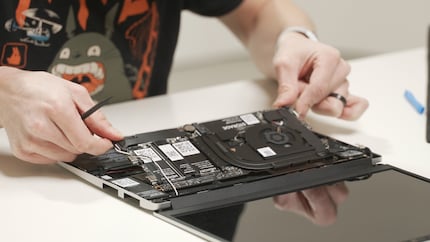
Product test
Testing Framework: the last laptop you’ll ever want to buy
by Philipp Rüegg
Framework is a laptop that you can repair completely by yourself – or so the manufacturer claims. Time to test how easy this is, as the mainboard on mine is broken.
The concept of the Framework laptop is unique. You can choose the equipment, upgrade it at any time and freely select connections with plug-in modules. In addition, users should be able to replace and repair each element themselves. Luckily for you, my laptop is in dire need of attention.
As noted in my review, my laptop wouldn’t boot reliably. I often had to press the start button several times until anything happened. Framework support provided me with various possible solutions in the past few weeks, always quickly and promptly: removing the motherboard’s battery, trying a single RAM bar, checking battery connector –
none of it helped. Instead, the problem just got worse. The laptop only turned on when a power adapter was connected. At that point, support had to send me a replacement mainboard. Which I had to install myself.

Framework provides useful instructions with pictures and videos for any job. Including mainboard replacements. It contains 34 steps. Estimated time required: 10 to 15 minutes. Difficulty: medium. I’ve already tinkered with the Framework quite a bit, so I’m sure I won’t finish in the stated time. For a speedy fix, carefully reading the instructions might be useful. Yet in my zeal, I unscrewed the case first instead of removing the connector modules before that. Back to the start, it’s rewind time.
As I’ve already used the support service a few times, most of the steps are already known to me. Here’s the condensed version:
It took me about 30 minutes, but there were no further complications following my false start. Just a little scare to end on: even with the new mainboard, nothing happened when I initially pressed the start button. Only when I connected a power supply did this Sleeping Beauty awake from its slumber. Was this all in vain? Thankfully not. The CMOS battery might’ve simply been empty and needed some juice, because after a few hours of charging, the Framework booted again without startup assistance. Hurray!

But that wasn’t the end of it. A new problem: The Wi-Fi wasn’t working. I checked Windows Device Manager: the device wasn’t starting. Great. So I grabbed my screwdriver to once again remove and reinstall the card. Still, no Wi-Fi. Maybe it was a driver problem? I connected a power cable via a USB-C adapter and downloaded the latest driver for the AX210 Wi-Fi card from Intel. But even with that, it wouldn’t run. Out of ideas, I installed Intel’s automatic driver update tool. Lo and behold, it found a newer driver, installed it and boom! The notebook was back online.
Framework has kept its promise. Even larger repairs such as replacing a motherboard can be done by the end user without much prior knowledge. The instructions are understandable and the individual steps are manageable without a computer science background. However, the fact that a new problem occurred after my fix made it clear that Framework is probably not a laptop for the masses. You have to be patient and need to enjoy troubleshooting. I’m more of the former than the latter. But still, after a successful support odyssey, my recommendation of the Framework laptop concept has been confirmed. More manufacturers should put tools in the hands of willing users. Long live the DIY laptop. Literally.
As a child, I wasn't allowed to have any consoles. It was only with the arrival of the family's 486 PC that the magical world of gaming opened up to me. Today, I'm overcompensating accordingly. Only a lack of time and money prevents me from trying out every game there is and decorating my shelf with rare retro consoles.
Practical solutions for everyday problems with technology, household hacks and much more.
Show all